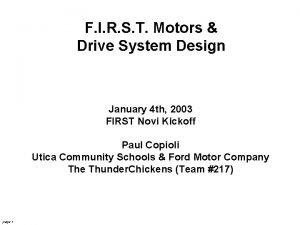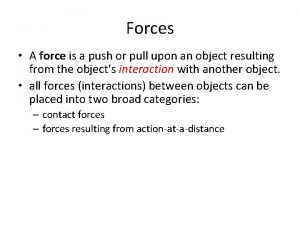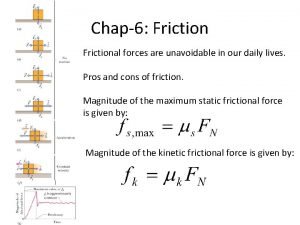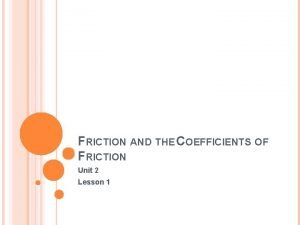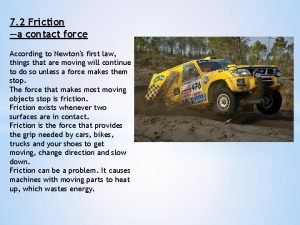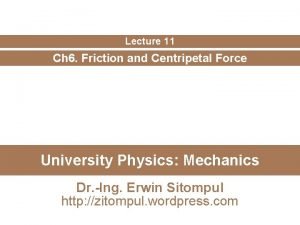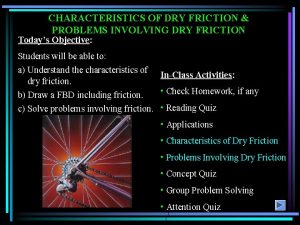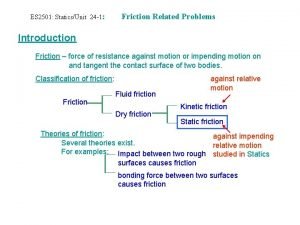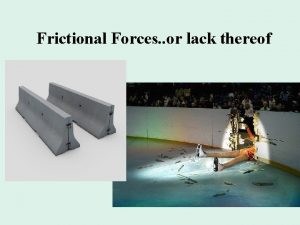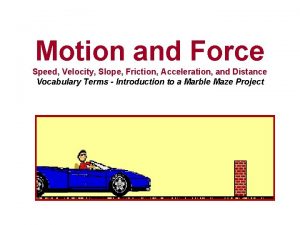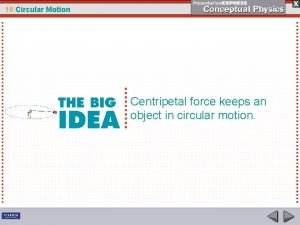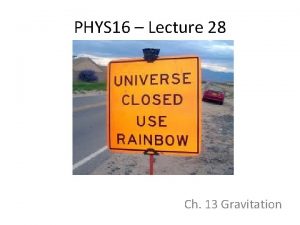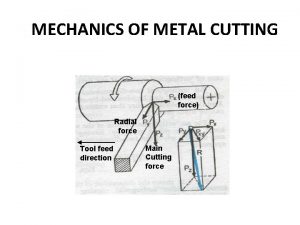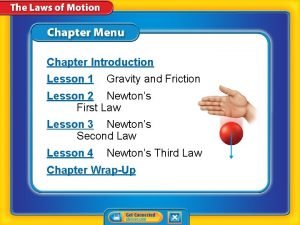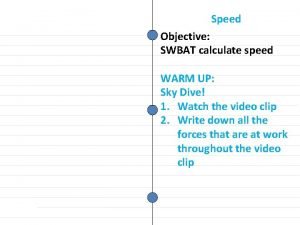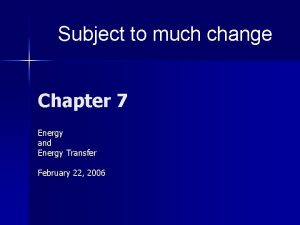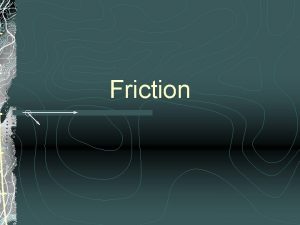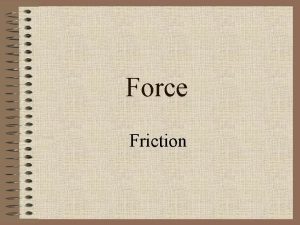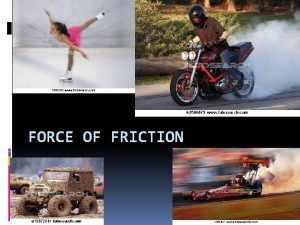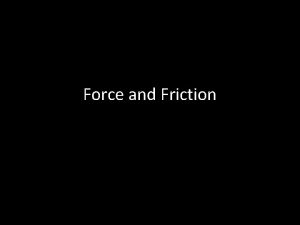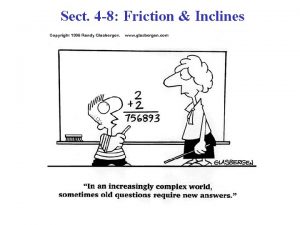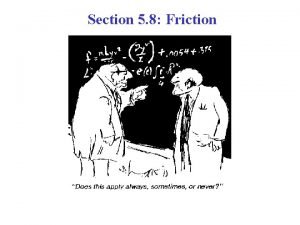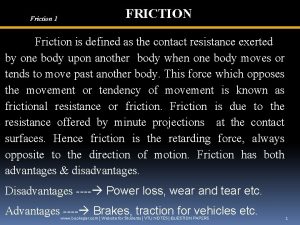Friction Ffriction FNormal Ff FN Ff friction force






















































- Slides: 54

Friction Ffriction = μFNormal

Ff = μFN • Ff = friction force (direction is always the opposite of velocity causing it to slow objects down)

Ff = μFN • Ff = friction force (direction is always the opposite of velocity causing it to slow objects down) • μ = coefficient of friction (experimentally determined value based on the two surfaces in contact with one another)

Ff = μFN • Ff = friction force (direction is always the opposite of velocity causing it to slow objects down) • μ = coefficient of friction (experimentally determined value based on the two surfaces in contact with one another) • FN = normal force (force perpendicular to the surface boundary)

Types of Friction • static friction – friction that prevents an object from moving.

Types of Friction • static friction – friction that prevents an object from moving. • kinetic (sliding) friction – friction that slows down an object in motion.

Types of Friction • static friction – friction that prevents an object from moving. • kinetic (sliding) friction – friction that slows down an object in motion. • static friction is always greater than kinetic friction for the same object.

Types of Friction • static friction – friction that prevents an object from moving. • kinetic (sliding) friction – friction that slows down an object in motion. • static friction is always greater than kinetic friction for the same object. • This means that it takes more force to get an object moving than it takes to keep it moving.

Friction on Horizontal Surfaces • On a horizontal surface, the normal force will always be equal to the weight of the object.

Friction on Horizontal Surfaces • On a horizontal surface, the normal force will always be equal to the weight of the object. • Example: You push a 25. 0 kg wooden box across a wooden floor at a constant speed. How much force do you exert on the box?

Example: You push a 25. 0 kg wooden box across a wooden floor at a constant speed. How much force do you exert on the box? • Start by drawing a free-body diagram.

Example: You push a 25. 0 kg wooden box across a wooden floor at a constant speed. How much force do you exert on the box? • Start by drawing a free-body diagram.

Example: You push a 25. 0 kg wooden box across a wooden floor at a constant speed. How much force do you exert on the box? • Start by drawing a free-body diagram. • All of the forces must cancel out because the box is moving at a constant speed.

• This means that the pushing force must be the same magnitude as the friction force.

• This means that the pushing force must be the same magnitude as the friction force. • The coefficient of friction can be obtained from the table on p. 129. We want the value for kinetic friction since the box is moving.

• This means that the pushing force must be the same magnitude as the friction force. • The coefficient of friction can be obtained from the table on p. 129. We want the value for kinetic friction since the box is moving. • The normal force will be the weight of the box since the surface boundary is horizontal.

• This means that the pushing force must be the same magnitude as the friction force. • The coefficient of friction can be obtained from the table on p. 129. We want the value for kinetic friction since the box is moving. • The normal force will be the weight of the box since the surface boundary is horizontal. • Ff = (0. 20)(25. 0 kg x 9. 80 m/s 2) = 49. 0 N

Calculate the minimum force required to get the box moving from rest in the previous example.

Calculate the minimum force required to get the box moving from rest in the previous example. • This time we must use the coefficient of static friction from the table. The normal force remains the same.

Calculate the minimum force required to get the box moving from rest in the previous example. • This time we must use the coefficient of static friction from the table. The normal force remains the same. • Ff = (0. 50)(25. 0 kg x 9. 80 m/s 2) = 123 N

Calculate the minimum force required to get the box moving from rest in the previous example. • This time we must use the coefficient of static friction from the table. The normal force remains the same. • Ff = (0. 50)(25. 0 kg x 9. 80 m/s 2) = 123 N • It takes 123 N to get the box moving, but just 49 N to keep it moving.

Why do you suppose it is bad to lock the brakes on a moving vehicle?

Why do you suppose it is bad to lock the brakes on a moving vehicle? • When the wheel is not spinning, the friction produced is kinetic friction.

Why do you suppose it is bad to lock the brakes on a moving vehicle? • When the wheel is not spinning, the friction produced is kinetic friction. • When the wheel is spinning, static friction is taking place.

Why do you suppose it is bad to lock the brakes on a moving vehicle? • When the wheel is not spinning, the friction produced is kinetic friction. • When the wheel is spinning, static friction is taking place. • Because static friction is always greater, there is more friction between your tires and the road when the wheels are spinning. This gives you greater control over the vehicle.

What pushing force is needed to accelerate the 25. 0 kg box at a rate of 1. 0 m/s 2?

What pushing force is needed to accelerate the 25. 0 kg box at a rate of 1. 0 m/s 2? • Draw another free body diagram.

What pushing force is needed to accelerate the 25. 0 kg box at a rate of 1. 0 m/s 2? • Draw another free body diagram.

What pushing force is needed to accelerate the 25. 0 kg box at a rate of 1. 0 m/s 2? • Draw another free body diagram. • To get the box to accelerate, the pushing force has to be greater than the friction force.

• The net force can be calculated using Newton’s 2 nd Law (Fnet = ma)

• The net force can be calculated using Newton’s 2 nd Law (Fnet = ma) • Fnet = (25. 0 kg)(1. 0 m/s 2) = 25 N

• The net force can be calculated using Newton’s 2 nd Law (Fnet = ma) • Fnet = (25. 0 kg)(1. 0 m/s 2) = 25 N • This means that the pushing force is 25 N greater than the friction force.

• The net force can be calculated using Newton’s 2 nd Law (Fnet = ma) • Fnet = (25. 0 kg)(1. 0 m/s 2) = 25 N • This means that the pushing force is 25 N greater than the friction force. • The friction force is always the same for this box on this surface Ff = (0. 20)(25. 0 kg x 9. 80 m/s 2) = 49. 0 N

• The net force can be calculated using Newton’s 2 nd Law (Fnet = ma) • Fnet = (25. 0 kg)(1. 0 m/s 2) = 25 N • This means that the pushing force is 25 N greater than the friction force. • The friction force is always the same for this box on this surface Ff = (0. 20)(25. 0 kg x 9. 80 m/s 2) = 49. 0 N • The pushing force must be 74. 0 N (49 + 25).

Homework • Read section 5. 2 (p. 126 -130) • Problems 17 -26 beginning on p. 128

Friction on an incline

Friction on an incline • The normal force is no longer the weight of the object.

Friction on an incline • The normal force is no longer the weight of the object. • The weight vector can be broken down into 2 components, parallel to the incline and perpendicular to the incline.

Friction on an incline • The normal force is no longer the weight of the object. • The weight vector can be broken down into 2 components, parallel to the incline and perpendicular to the incline.

Friction on an incline • The normal force is no longer the weight of the object. • The weight vector can be broken down into 2 components, parallel to the incline and perpendicular to the incline. • The perpendicular component is the normal force.

Friction on an incline • The normal force is no longer the weight of the object. • The weight vector can be broken down into 2 components, parallel to the incline and perpendicular to the incline. • The perpendicular component is the normal force. • The parallel component represents a pulling force.

Calculating normal force • SOH CAH TOA can be used to determine both the normal force and the pulling force.

Calculating normal force • SOH CAH TOA can be used to determine both the normal force and the pulling force. • cos 21 o = FN/weight (w = mg)

Calculating normal force • SOH CAH TOA can be used to determine both the normal force and the pulling force. • cos 21 o = FN/weight (w = mg) • sin 21 o = Fpull/weight (w = mg)

Determine the coefficient of static friction for a metal box on a wooden ramp if the box has a mass of 13. 5 kg and begins to slide down the ramp when the incline reaches 38 o.

Determine the coefficient of static friction for a metal box on a wooden ramp if the box has a mass of 13. 5 kg and begins to slide down the ramp when the incline reaches 38 o. • Start by drawing a free-body diagram. It is helpful to draw the weight force as 2 component forces (parallel and perpendicular)

Determine the coefficient of static friction for a metal box on a wooden ramp if the box has a mass of 13. 5 kg and begins to slide down the ramp when the incline reaches 38 o. • Start by drawing a free-body diagram. It is helpful to draw the weight force as 2 component forces (parallel and perpendicular) • The box will begin to slide when the friction force and the parallel force are equal.

Determine the coefficient of static friction for a metal box on a wooden ramp if the box has a mass of 13. 5 kg and begins to slide down the ramp when the incline reaches 38 o. • Start by drawing a free-body diagram. It is helpful to draw the weight force as 2 component forces (parallel and perpendicular) • The box will begin to slide when the friction force and the parallel force are equal. • sin 38 o = (F||)/(132 N)

Determine the coefficient of static friction for a metal box on a wooden ramp if the box has a mass of 13. 5 kg and begins to slide down the ramp when the incline reaches 38 o. • Start by drawing a free-body diagram. It is helpful to draw the weight force as 2 component forces (parallel and perpendicular) • The box will begin to slide when the friction force and the parallel force are equal. • sin 38 o = (F||)/(132 N) • F|| = 81. 3 N

• F|| = 81. 3 N • Next, we need to determine the normal force (perpendicular component) to use in the friction equation.

• F|| = 81. 3 N • Next, we need to determine the normal force (perpendicular component) to use in the friction equation. • cos 38 o = (FN)/(132 N)

• F|| = 81. 3 N • Next, we need to determine the normal force (perpendicular component) to use in the friction equation. • cos 38 o = (FN)/(132 N) • FN = 104 N

• F|| = 81. 3 N • Next, we need to determine the normal force (perpendicular component) to use in the friction equation. • cos 38 o = (FN)/(132 N) • FN = 104 N • Now, we can solve for μ. 81. 3 N = μ(104 N)

• F|| = 81. 3 N • Next, we need to determine the normal force (perpendicular component) to use in the friction equation. • cos 38 o = (FN)/(132 N) • FN = 104 N • Now, we can solve for μ. 81. 3 N = μ(104 N) μ = 0. 782
 Ff= μ fn
Ff= μ fn Fnormal
Fnormal Fnormal
Fnormal Is air resistance a noncontact force
Is air resistance a noncontact force Jill is climbing
Jill is climbing Hibbeler
Hibbeler What two factors affect the force of friction
What two factors affect the force of friction Pushing a box
Pushing a box Nature of force
Nature of force How to determine magnitude of friction force
How to determine magnitude of friction force Frictional force formula
Frictional force formula Friction force
Friction force Finding force of friction
Finding force of friction Units of friction
Units of friction Is friction a contact force
Is friction a contact force Friction and centripetal force
Friction and centripetal force Fluids
Fluids Friction force characteristics
Friction force characteristics Types of friction
Types of friction Frictional force definition
Frictional force definition Friction force
Friction force What force provides centripetal force
What force provides centripetal force Why electric field is conservative
Why electric field is conservative Internal forces
Internal forces Contact vs noncontact forces
Contact vs noncontact forces Advantage
Advantage Centripetal force and gravitational force
Centripetal force and gravitational force Which arrow below represents the direction of acceleration
Which arrow below represents the direction of acceleration Unbalanced force
Unbalanced force Long range force
Long range force Hooke's law vector form
Hooke's law vector form Centrifugal force in india
Centrifugal force in india Feed force in orthogonal cutting
Feed force in orthogonal cutting Self threaded pin
Self threaded pin Factors affecting friction
Factors affecting friction Pericardiatis
Pericardiatis Condensed q formula for 3 inch hose
Condensed q formula for 3 inch hose Friction transforms mechanical energy to
Friction transforms mechanical energy to Chapter 2 lesson 1 gravity and friction
Chapter 2 lesson 1 gravity and friction Bill nye friction worksheet
Bill nye friction worksheet Air resistance
Air resistance Reynolds number for pipe flow
Reynolds number for pipe flow Friction stem activity
Friction stem activity Gravity and friction
Gravity and friction Kinetic energy numericals
Kinetic energy numericals Unit for friction
Unit for friction Fluid friction picture
Fluid friction picture Friction word
Friction word What does friction
What does friction Friction with english and swedish neighbors
Friction with english and swedish neighbors Runway friction testing
Runway friction testing Friction
Friction Negative skin friction on a pile
Negative skin friction on a pile Cardiac landmarks
Cardiac landmarks Take out your homework
Take out your homework

